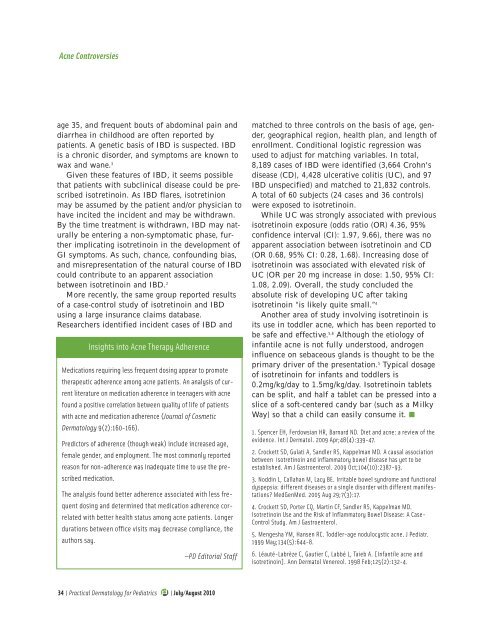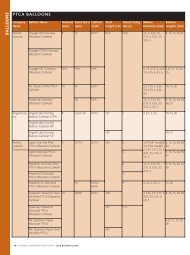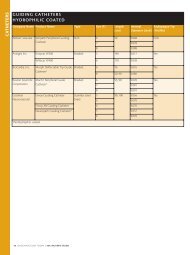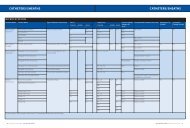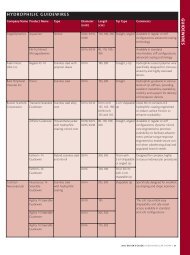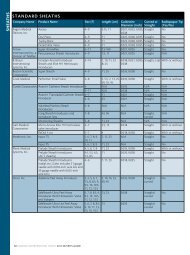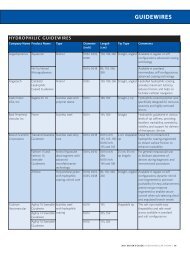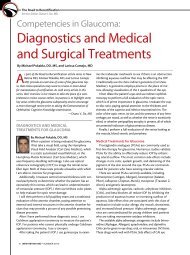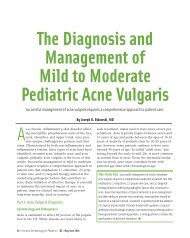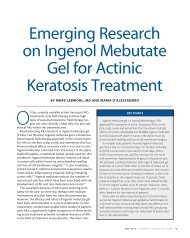Acne Controversies: An Update Based on Recent Findings
Acne Controversies: An Update Based on Recent Findings
Acne Controversies: An Update Based on Recent Findings
Create successful ePaper yourself
Turn your PDF publications into a flip-book with our unique Google optimized e-Paper software.
<str<strong>on</strong>g>Acne</str<strong>on</strong>g> <str<strong>on</strong>g>C<strong>on</strong>troversies</str<strong>on</strong>g><br />
age 35, and frequent bouts of abdominal pain and<br />
diarrhea in childhood are often reported by<br />
patients. A genetic basis of IBD is suspected. IBD<br />
is a chr<strong>on</strong>ic disorder, and symptoms are known to<br />
wax and wane. 3<br />
Given these features of IBD, it seems possible<br />
that patients with subclinical disease could be prescribed<br />
isotretinoin. As IBD flares, isotretini<strong>on</strong><br />
may be assumed by the patient and/or physician to<br />
have incited the incident and may be withdrawn.<br />
By the time treatment is withdrawn, IBD may naturally<br />
be entering a n<strong>on</strong>-symptomatic phase, further<br />
implicating isotretinoin in the development of<br />
GI symptoms. As such, chance, c<strong>on</strong>founding bias,<br />
and misrepresentati<strong>on</strong> of the natural course of IBD<br />
could c<strong>on</strong>tribute to an apparent associati<strong>on</strong><br />
between isotretinoin and IBD. 2<br />
More recently, the same group reported results<br />
of a case-c<strong>on</strong>trol study of isotretinoin and IBD<br />
using a large insurance claims database.<br />
Researchers identified incident cases of IBD and<br />
Insights into <str<strong>on</strong>g>Acne</str<strong>on</strong>g> Therapy Adherence<br />
Medicati<strong>on</strong>s requiring less frequent dosing appear to promote<br />
therapeutic adherence am<strong>on</strong>g acne patients. <str<strong>on</strong>g>An</str<strong>on</strong>g> analysis of current<br />
literature <strong>on</strong> medicati<strong>on</strong> adherence in teenagers with acne<br />
found a positive correlati<strong>on</strong> between quality of life of patients<br />
with acne and medicati<strong>on</strong> adherence (Journal of Cosmetic<br />
Dermatology 9(2):160-166).<br />
Predictors of adherence (though weak) include increased age,<br />
female gender, and employment. The most comm<strong>on</strong>ly reported<br />
reas<strong>on</strong> for n<strong>on</strong>-adherence was inadequate time to use the prescribed<br />
medicati<strong>on</strong>.<br />
The analysis found better adherence associated with less frequent<br />
dosing and determined that medicati<strong>on</strong> adherence correlated<br />
with better health status am<strong>on</strong>g acne patients. L<strong>on</strong>ger<br />
durati<strong>on</strong>s between office visits may decrease compliance, the<br />
authors say.<br />
—PD Editorial Staff<br />
matched to three c<strong>on</strong>trols <strong>on</strong> the basis of age, gender,<br />
geographical regi<strong>on</strong>, health plan, and length of<br />
enrollment. C<strong>on</strong>diti<strong>on</strong>al logistic regressi<strong>on</strong> was<br />
used to adjust for matching variables. In total,<br />
8,189 cases of IBD were identified (3,664 Crohn's<br />
disease (CD), 4,428 ulcerative colitis (UC), and 97<br />
IBD unspecified) and matched to 21,832 c<strong>on</strong>trols.<br />
A total of 60 subjects (24 cases and 36 c<strong>on</strong>trols)<br />
were exposed to isotretinoin.<br />
While UC was str<strong>on</strong>gly associated with previous<br />
isotretinoin exposure (odds ratio (OR) 4.36, 95%<br />
c<strong>on</strong>fidence interval (CI): 1.97, 9.66), there was no<br />
apparent associati<strong>on</strong> between isotretinoin and CD<br />
(OR 0.68, 95% CI: 0.28, 1.68). Increasing dose of<br />
isotretinoin was associated with elevated risk of<br />
UC (OR per 20 mg increase in dose: 1.50, 95% CI:<br />
1.08, 2.09). Overall, the study c<strong>on</strong>cluded the<br />
absolute risk of developing UC after taking<br />
isotretinoin “is likely quite small.” 4<br />
<str<strong>on</strong>g>An</str<strong>on</strong>g>other area of study involving isotretinoin is<br />
its use in toddler acne, which has been reported to<br />
be safe and effective. 5,6 Although the etiology of<br />
infantile acne is not fully understood, androgen<br />
influence <strong>on</strong> sebaceous glands is thought to be the<br />
primary driver of the presentati<strong>on</strong>. 5 Typical dosage<br />
of isotretinoin for infants and toddlers is<br />
0.2mg/kg/day to 1.5mg/kg/day. Isotretinoin tablets<br />
can be split, and half a tablet can be pressed into a<br />
slice of a soft-centered candy bar (such as a Milky<br />
Way) so that a child can easily c<strong>on</strong>sume it. ■<br />
1. Spencer EH, Ferdowsian HR, Barnard ND. Diet and acne: a review of the<br />
evidence. Int J Dermatol. 2009 Apr;48(4):339-47.<br />
2. Crockett SD, Gulati A, Sandler RS, Kappelman MD. A causal associati<strong>on</strong><br />
between isotretinoin and inflammatory bowel disease has yet to be<br />
established. Am J Gastroenterol. 2009 Oct;104(10):2387-93.<br />
3. Noddin L, Callahan M, Lacy BE. Irritable bowel syndrome and functi<strong>on</strong>al<br />
dyspepsia: different diseases or a single disorder with different manifestati<strong>on</strong>s?<br />
MedGenMed. 2005 Aug 29;7(3):17.<br />
4. Crockett SD, Porter CQ, Martin CF, Sandler RS, Kappelman MD.<br />
Isotretinoin Use and the Risk of Inflammatory Bowel Disease: A Case-<br />
C<strong>on</strong>trol Study. Am J Gastroenterol.<br />
5. Mengesha YM, Hansen RC. Toddler-age nodulocystic acne. J Pediatr.<br />
1999 May;134(5):644-8.<br />
6. Léauté-Labrèze C, Gautier C, Labbé L, Taieb A. [Infantile acne and<br />
isotretinoin]. <str<strong>on</strong>g>An</str<strong>on</strong>g>n Dermatol Venereol. 1998 Feb;125(2):132-4.<br />
34 | Practical Dermatology for Pediatrics | July/August 2010


